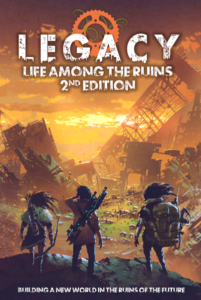
Legacy: Life Among the Ruins
Legacy: Life Among the Ruins is a post-apocalyptic role-playing game, written by Jay Iles and Douglas Santana Mota, published by UFO Press, and distributed by Modiphius Entertainment.
By Aaron T. Huss

Learn more about Legacy: Life Among the Ruins here
Purchase Legacy: Life Among the Ruins here
Find other Legacy: Life Among the Ruins posts here
Legacy: Life Among the Ruins is a post-apocalyptic game powered by the same engine powering Apocalypse World, but puts a bit of a spin on both of those aspects. As with all Powered by the Apocalypse (PbtA) games, Legacy is a standalone role-playing game with its own set of rules. Unlike many PbtA games, it is inspired and designed similar to Apocalypse World, but incorporates many changes to make it unique to its own setting and conceptual design.
For starters, many post-apocalyptic games focus on a band of characters trekking across the wasteland battling vile beings while struggling to survive in a world significantly altered by the apocalyptic event. Legacy focuses less on the survival aspects and instead focuses more on the rebuilding aspects. Survival is still a theme that runs throughout, but it isn’t the main theme and sometimes takes a back seat to storytelling that involves how players deal with rebuilding their community in the ruins of a world their ancestors once new. It doesn’t have to be a wasteland, although the wasteland certainly exists, and deals with more social, political, informational, and technological interaction.
Don’t think this is a tabletop role-playing version of Sim City after the apocalypse. Every player controls a family, but every player also controls a character (or even a collection of characters) that are utilized to zoom in on the action. This is one of the major deviations from PbtA in that Legacy players have two playbooks to manage – one family and one character. Each one has its own traits, moves, and various attributes. Additionally, each one interacts different with the other player’s family and character playbooks. Whereas families are involved in communal storytelling for things like goods, treaties, resources, and wonders, characters are involved in combat and the nitty gritty, minute details.
Legacy also comes with a flexible setting that supports different styles of technology gameplay – modern style technology, bizarre technology, and full-fledged sci-fi fantasy post-apocalyptic. You can thus play Legacy over and over again and create a completely different experience each time just by adjusting the technology scale. This does mean the book has to support all three technology styles with different family and character playbooks, different adversarial organizations, different aspects to the setting, and of course a bestiary that supports a sliding scale. To finish things off, Legacy includes an example setting to get you playing right away.
I personally like the concepts of post-apocalyptic, but really lose my interest when it’s over-the-top sci-fi fantasy. Legacy avoids that and keeps things on a lower level. You can scale things up if you want, but I feel as though the book tries to focus more on the horror aspects of post-apocalyptic rather than the fantasy aspects. However, another aspect I like is fun-with-equipment. Post-apocalyptic often allows you to turn the most mundane into rudimentary weapons. Unfortunately Legacy lacks in the equipment section and focuses more on the various tags of weapons rather than providing you with a huge list to choose from. It’s a “create it yourself and use these mechanics to guide the process” design. Not my preference for design, but that is just a personal preference. You can definitely work with your GM to create a huge variety of weapons based on items you would see day-to-day or in your favorite near-future sci-fi novels.
Legacy: Life Among the Ruins was funded through Kickstarter and is a beautiful product from beginning to end. The artwork looks great, the layout looks great, the writing and editing are great, and the book flows generally well from beginning to end. I say this because I’ve seen some Kickstarter-funded books that focus way more on artwork and layout while neglecting writing, editing, and content flow. And for the GM, there’s plenty of content to keep you going from game session to game session.


